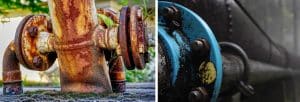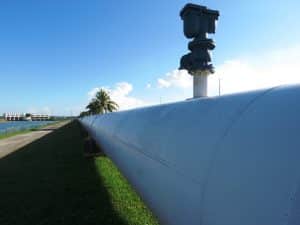1. Introduction
Commercial pipelines carrying oil, gas, or a variety of industrially-relevant chemicals all over the world traverse millions of miles across virtually every type of terrain. Safe delivery of these commodities is crucial; however, as a result of constant exposure to atmospheric conditions and/or the corrosive chemicals themselves, pipeline failures and material spills occur somewhat regularly despite our best efforts. In the US alone, on average there have been around 10-20 incidents per year over the past two decades. Of these incidents, roughly 75% occurred due to corrosion or pitting, causing the carbon or low-alloy steel pipes to fracture and leak. Mitigation of this corrosion problem is therefore of utmost importance.

Corrosion of commercial pipelines is a persistent issue that has resulted in significant research efforts from universities and oil/energy companies alike.
Early research techniques for investigating pipeline corrosion were not convenient or easy. Interstate pipelines are typically several feet in diameter and transport tremendous quantities of fluid over long periods of time. To simulate this system, it was necessary to either construct a representative pipeline section and circulate huge volumes of fluid over a long time, or else perform a type of “wheel test” or “cage test” where a slightly more manageable experimental setup could be used in place of an actual pipeline. However, while these tests are easier and certainly less expensive than a physical pipeline setup, they can still be rather material-intensive, bulky or tricky to handle, and often suffer from inefficiencies and inaccurate data.
2. Electrochemistry Applied to Corrosion
Electrochemistry has opened the door to easier, more efficient techniques for studying pipeline corrosion in recent years. Experimentally, the flow of fluid through a stationary steel pipe is scaled down and simulated by instead rotating a cylindrical steel coupon (representing the pipeline) in a glass cell containing usually just 1 L of liquid (representing internal or external pipeline fluids, e.g. oil and/or saltwater). This setup eliminates the need to continuously flow fluid, which is costly and often difficult to implement in a laboratory setting, and reduces the size and cost of pipeline steel under study. Considering such research is aimed at intentionally corroding the steel being studied, having a small and conveniently-changed cylindrical sample is a huge benefit to facilitate efficient experiment turnover. This type of electrochemical experiment is referred to as a Rotating Cylinder Electrode (RCE) test.
Versatility with the cylindrical coupon (also called a cylinder insert) design of an RCE test allows multiple different materials to be easily studied using the same experimental setup. For example, many researchers study common and inexpensive metals, like 1018 carbon steel, while others need to test stainless steel alloys, like 303, 304, or 316. An RCE setup enables the user to simply change cylinder inserts as desired while maintaining consistency with the remaining experimental parameters and hardware.
The most popular electrochemical method used with RCE testing is called Linear Polarization Resistance (LPR). During LPR, an electrochemical workstation is used to slowly and smoothly monitor the potential of the cylinder insert near its measured Open Circuit Potential (OCP), typically while the cylinder is rotated at varying rotation rates using an electrode rotator like the MSR evo. Rotation of the electrode in solution creates turbulent flow and simulates the shear stress experienced at the wall of a real pipeline during operation. Read more on the details of mass transport limited corrosion with rotating cylinder electrodes and use our handy rotating cylinder pipe velocity to rotation rate calcualator to learn more.
3. References
- Lam, “Statistical Analyses of Historical Pipeline Incident Data with Application to the Risk Assessment of Onshore Natural Gas Transmission Pipelines” (2015), Electronic Thesis and Dissertation Repository, 2925.
- S. Papavinasam, R. W. Revie, and M. Bartos, “Testing Methods and Standards for Oilfield Corrosion Inhibitors” (2004), CORROSION 2004, NACE International, NACE-04424.
- F. H. Walters, J. D. Garber, and S. J. Garber, “Ranking Corrosion Inhibitors by Percent Protection Misleading”, Oil and Gas Journal 92:41 (1994).


